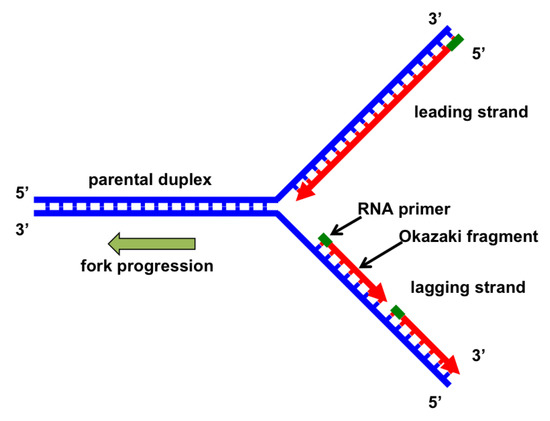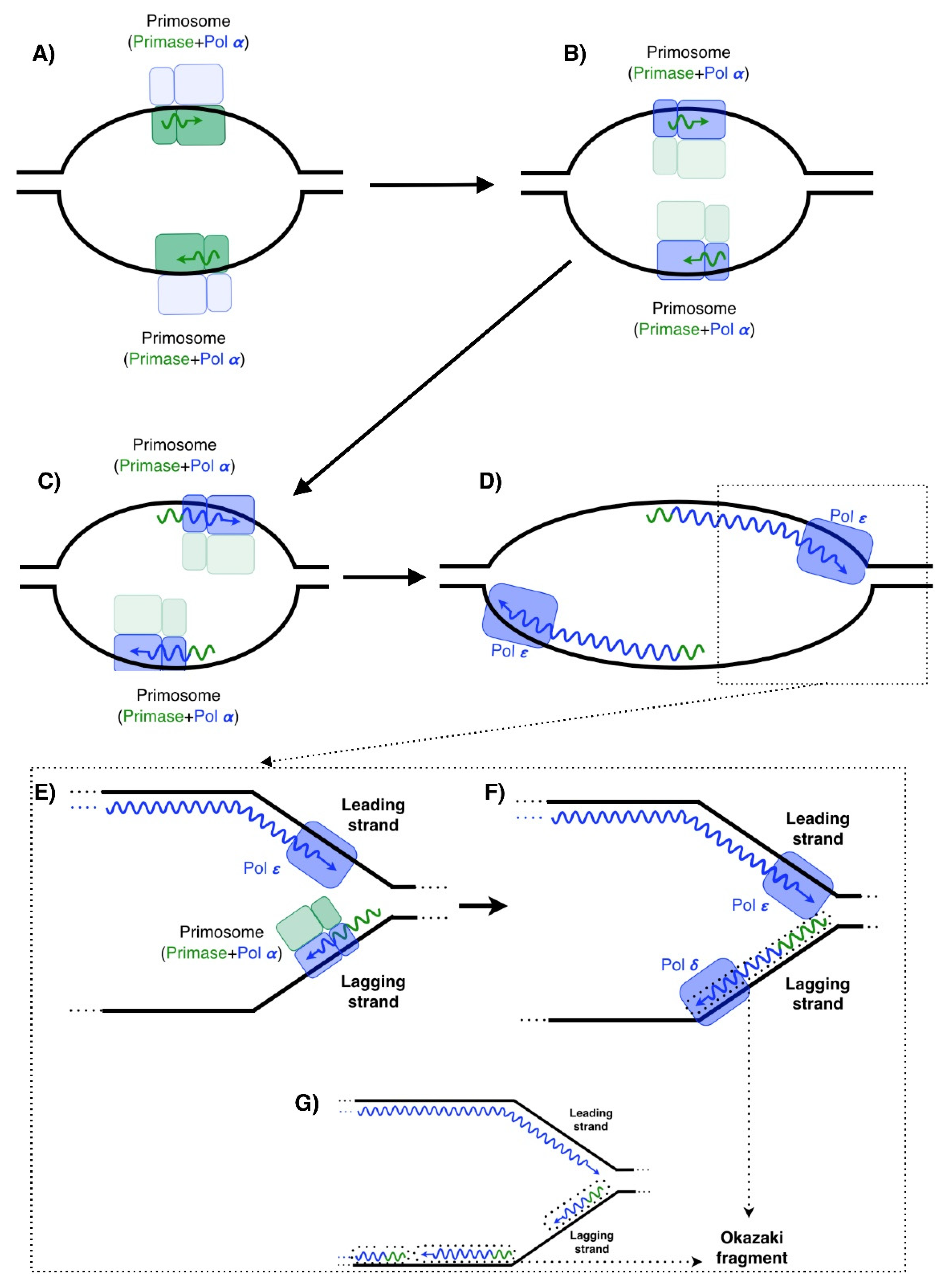Okazaki Fragments Are Found in All of the Following Except
Okazaki fragments are short newly synthesized DNA fragments that are formed on the lagging template strand during DNA replication Wiki User 2013-01-21 160604. Because DNA polymerases cannot initiate DNA synthesis each Okazaki fragment is primed with a short RNA.

Genes Free Full Text The Replication Fork Understanding The Eukaryotic Replication Machinery And The Challenges To Genome Duplication Html
PLEASE ANSWER ALL OF THE FOLLOWING QUESTIONS.

. D They begin with an RNA primer. All of the following are characteristics of Okazaki fragments EXCEPT. In DNA replication what is the function of DNA pol.
- Eukaryotic chromosomes are a complex of DNA and DNA-binding proteins whereas the structure of prokaryotic chromosomes is simpler. - In eukaryotes the Okazaki fragments are smaller 100-150 nucleotides than those found in prokaryotes. Now these enzymes are direction specific means they only work.
Question A ll occur during DNA replication in E. The Okazaki fragments are then joined together to form a continuous new DNA strand. The Okazaki fragments are only on the leading strands.
Chargaff found that the amount of adenine present in DNA always equals the amount of thymine and the amount of guanine always equals the amount of cytosine. The daughter strands are formed by the help of DNA primate and DNA polymerase enzymes. They make up the lagging strand of replicated DNA.
Like all nucleic acid polymerization of the lagging strand occurs in the 5-to-3 direction and never occurs in the opposite direction. All of the following are characteristics of Okazaki fragments EXCEPT. They are checked for accuracy by DNA polymerase III.
They form short double-stranded DNA sections that lie between 1000 and 2000 nucleotides in prokaryotes. View the full answer. The production of a continuous new strand of DNA using the many separate Okazaki fragments in other words the joining of the already made fragments found on the lagging strand requires all of the following except which one.
A They make up the leading strand of replicating DNA. Okazaki fragments was discovered by Reiji Okazaki and colleguesDuring replication of DNA molecules lagging strand is synthesised on 5-3strandof DNA in short segments of 1000 to 2000 NT in 5. Okazaki fragments are found in all of the following EXCEPT A leading strand.
Discontinuous Replication Generates Okazaki Fragments. What is a okazaki fragment. A it only reqires one RNA primer b it forms DNA segmens called Okazaki fragments c the polymerase moves away from the replication fork 2.
Okazaki fragment is a short newly-synthesized DNA fragment on the lagging template strand formed during DNA replication. E They make up the lagging strand of replicating DNA. They are longer in eukaryotic cells.
Question 7 Multiple Choice 0 points Modify Remove Question All are characteristics of Okazaki fragments EXCEPT. C They are a part of DNA replication. Okazaki fragments in bacteria and in bacteriophage T4 are 10002000 nucleotides long but are only about 100300 nucleotides in eukaryotes.
Okazaki fragments are found in all of the following EXCEPT in. B They are joined together by DNA ligase. They begin with an RNA primer.
D linear replication models. All of the following statements about lagging strand synthesis are true EXCEPT. Therefore Okazaki fragments are complementary to the lagging strand which runs in the 5 to 3 direction.
Successful DNA synthesis requires all of the following EXCEPT A. The production of a continuous new strand of DNA using the many separate Okazaki fragments in other words the joining of the already made fragments found on the lagging strand requires all of the following except which one. It was originally discovered in 1968 by Reiji Okazaki Tsuneko Okazaki and their colleagues while studying replication of bacteriophage DNA in Escherichia coli.
Okazaki fragments was discovered by Reiji Okazaki and colleguesDuring replication of DNA molecules lagging strand is synthesised on 5-3strandof DNA in short. O the lagging strand o the leading strand O prokaryotic DNA O eukaryotic DNA. Answer helicase unwinds ds DNA at the replication fork.
The production of a continuous new strand of DNA using the many separate Okazaki fragments in other words the joining of the already made fragments found on the lagging. Okazaki fragments are found in all of the following EXCEPT a. An Okazaki fragment is a relatively short fragment of DNA with an RNA primer at the 5 terminus created on the lagging strand during DNA replication.
They are joined together by DNA ligase. In contrast the leading strand is synthesized continuously and does not need the same extensive ligation of DNA fragments.

Analysis Of The Okazaki Fragment Distributions Along Single Long Dnas Replicated By The Bacteriophage T4 Proteins Sciencedirect

Simplified Models Of Okazaki Fragment Maturation In Bacteria A Download Scientific Diagram

Polb Completes Okazaki Fragment Maturation After Pold Synthesis Stops Download Scientific Diagram

Simplified Models Of Okazaki Fragment Maturation In Bacteria A Download Scientific Diagram

Insights Into Okazaki Fragment Synthesis By The T4 Replisome Journal Of Biological Chemistry

Solved Part A Which Of The Following Statements Is False Chegg Com

Figure 9 10 You Isolate A Cell Strain In Which The Joining Together Of Okazaki Fragments Is Impaired And Suspect That A Mutation Has Occurred In An Enzyme Found At The Replication Fork

Okazaki Fragment Formation Function What Are Okazaki Fragments Video Lesson Transcript Study Com

Dna Replication Leading Strand Vs Lagging Strand Okazaki Fragments Youtube

Why Does A Lagging Strand Have Okazaki Fragments Quora

Okazaki Fragment An Overview Sciencedirect Topics

How Do Okazaki Fragments Form A Continuous Strand Quora

Analysis Of The Okazaki Fragment Distributions Along Single Long Dnas Replicated By The Bacteriophage T4 Proteins Sciencedirect

File Okazaki Fragment International No Text Svg Wikimedia Commons

Biomolecules Free Full Text Primpol A Breakthrough Among Dna Replication Enzymes And A Potential New Target For Cancer Therapy Html

Solved 18 Consider The Figure Below Illustrating Dna Replication Which Of The Following Statements Is True Dna Polymerase Molecule Parental Dna Replication Fork The Okazaki Fragments Don T Form A Daughter Dna Strand And
What Is Okazaki Fragments And What Is Its Function Quora

Possible Mechanisms Of Okazaki Fragments Of Maturation In S Download Scientific Diagram

Comments
Post a Comment